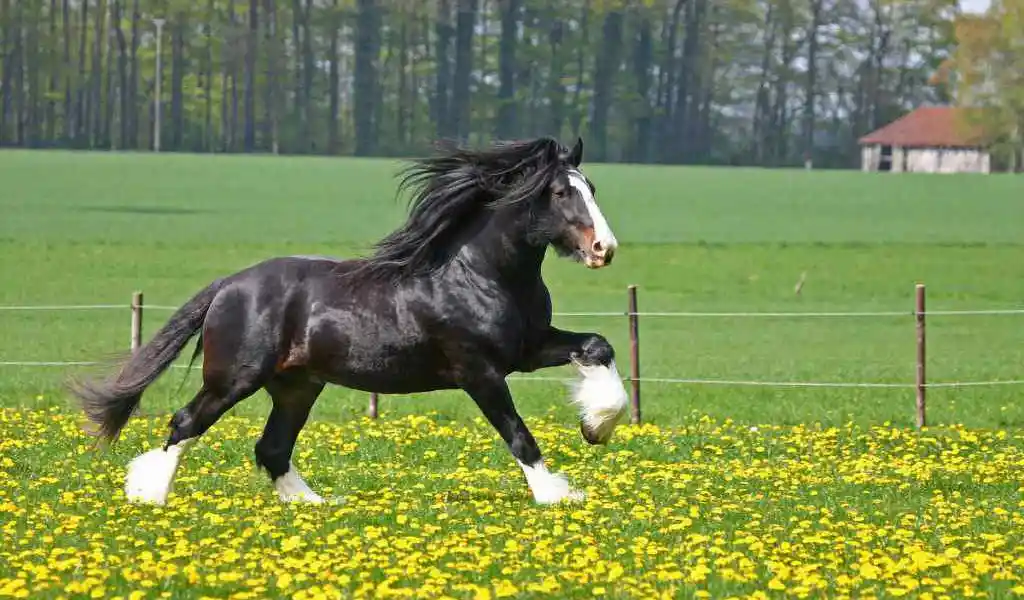The Shire is one of the largest horse breeds in the world.
They are known for their gentle temperament, and are often used as work horses or driving horses.
If you’re thinking about adding a Shire horse to your herd, here’s everything you need to know!
Shire Horse Breed Info
Here are some of the key things you need to know about the Shire horse:
| Height (size) | 16.0 – 17.2 hands high |
| Colors | Most commonly black, bay, gray or brown. In the UK chestnut color is not allowed, but it is in the U.S. White markings on legs and face are common, but large amounts of white markings are not desired. |
| Country of Origin | England |
| Common Uses | Forestry, carriage driving, showing, leisure riding, delivering ale from the breweries to the public houses |
Shire Horse Facts & Information (Breed Profile)
The Shire is a draught horse that was developed in the 17th century in England.
Shire horses got their name from the rural “shires,” or counties, in England, where they were historically used for agricultural work, heavy hauling, and even war.
The term “Shire horse” itself was first used in the mid 17th century.
History of the Breed
The breed is descended from the “Great Horse” that was popular in medieval England.
The “Great Horse” was a massive and powerful mount that could carry a knight and his armor weighing up to 400 pounds (180 kg) with agility and speed.
In the 16th century, Dutch engineers brought Friesian horses with them when they came to England to drain the fens, and these horses probably influenced the development of the Shire breed as well.
These Flemish horses were notable not only for their size, but also for their coloring and markings, which were very similar to those that we see as in the Shire breed today.
The “Packington Blind Horse” of Leicestershire is one of the most well-known horses of the time, with direct ancestors documented from 1770 to 1832.
This stallion is often regarded as the founding sire for the Shire breed, and he served as a stud from the years 1755 through 1770.
The Use of the Shire Horses in the Past
Such heavy horses had been utilized as war horses both on the Continent and in the British Isles; but, as England started colonizing other lands and its conflicts, when they happened, took place far from the British island, the Shire started to be used more in farming.
Huge amounts of cargo were transported both to and from English ports throughout the 1800s, and the Shire played a significant role in this.
During this same time period, agriculture created a need for hardy, obedient horses that could work the fields of either the flat, marshy counties known as “fen,” or the dry counties of Yorkshire and Lancashire.
The English Cart Horse Society was established in 1878, and in 1884, it became known as the Shire Horse Society after undergoing a name change.
In 1878, the Society released its first stud book, which included 2,381 stallions and records dating all the way back to 1770.
The Shire in the 20th Century
Draft horses became less necessary and were harder to keep around the time when World War II broke out as a result of increased mechanization and more strict restrictions on the purchase of feed for livestock, and so some big breeding studs closed, and thousands of Shires were slaughtered.
The breed didn’t start to make a comeback until the 1970s.
Since then, breed associations have been created in the United States, Canada, and Europe.
In the 1950s and 1960s, they were crossbred with the Clydesdale, which led to changes in the conformation of the Shire.
The most notable of these changes was the feathering on the lower legs, which transitioned from a mass of coarse hair to the silky feathering that is characteristic of modern Shires.
The biggest Shire event in the UK, the National Shire Horse Spring Show is still held every year.
Born at Toddington Mills in Bedfordshire (UK) by Thomas Cleaver, the Shire gelding Sampson (later called Mammoth) is credited with being both the tallest and heaviest horse ever recorded.
At 4 years old in 1850 he was 21.2½ hands high, and weighed 3,359 lbs (1,524 kg).
In the past Shire used to pull carts delivering ale from breweries to public places, and a few breweries in the UK still follow this practice today, notably the Wadworth Brewery, Hook Norton Brewery, Samuel Smith Brewery, and Thwaites Brewery.
If you’re interested in learning more about this fascinating breed, keep reading!
Alternative Names
n/a
Temperament/Personality
Gentle and easy-going
Physical Characteristics
The head is long and lean with big eyes.
The neck is slightly arched and long in proportion to the body, and the shoulder is deep and broad.
The back is muscular and short.
On the legs, there is not an excessive amount of feathering, and the hair is very fine, straight, and smooth.
While taller Shires, particularly those over 18.2 hands high, are used for showing, working horses are often preferred to be around 17 hands tall.
Colors
Most commonly black, bay, gray or brown.
In the UK chestnut color is not allowed, but it is in the U.S.
White markings on legs and face are common, but large amounts of white markings are not desired.
Height (size)
16.0 – 17.2 hands high
Stallions
17.0 – 17.2 hh
Mares
No less than 16.0 hh
Weight
850 – 1100 kg (1870 – 2430 lbs)
Blood Type
Cold
Common Uses
Forestry, carriage driving, showing, leisure riding, delivering ale from the breweries to the public houses
Health
They are at risk of chronic progressive lymphedema – a chronic progressive disease that includes symptoms of progressive swelling, hyperkeratosis, and fibrosis of distal limbs.
Popular Traits
Incredible pulling power
Feeding/Diet
n/a
Country of Origin
England
Ancestors
Old English Black Horse, Flemish horse, stallion Packington Blind Horse, Clydesdale
